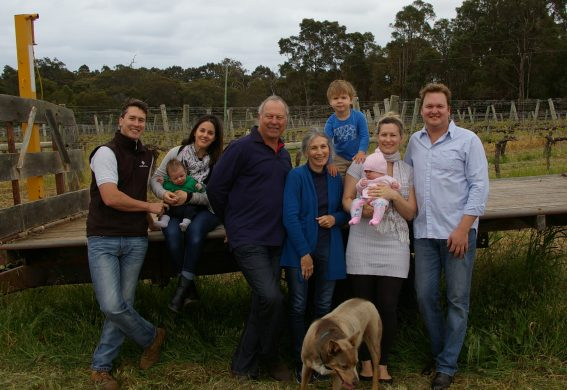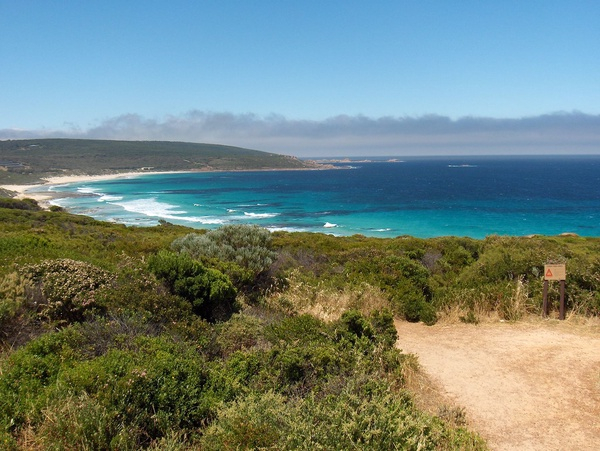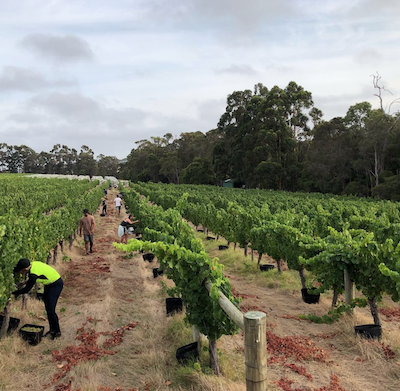
The phrase, "family business," might call to mind a mom-and-pop store or a depression-era farming family putting the kids to work to scrounge together a harvest. Today corporations like Amazon continue to rise to power... and I am frequently asked by customers why we don't carry the big-brand wine that was able to buy an ad spot on their favorite podcast. The novelty of a family business seems a far away and quaint idea. Cath and Kingsley Edwards of Ashbrook Estate remind us that these businesses do exist; they also remind us why they exist. These sustainable vineyards produce delicious wines in the unmatched Margaret River of Western Australia.
In James Halliday's Australian Wine Companion, Halliday, Australia's preeminent wine authority, addresses what so many winemakers and critics note:  how absolutely ideal and beautiful the weather is in Margaret River. Not far from the often friable and well-drained soils of the vineyards are beautiful beaches, havens for surfers and swimmers. Margaret River's climate is often compared to Bordeaux, but has even more maritime influence, being bordered on three sides by the Indian and Southern Oceans, bringing cool air in at night to help retain acidity in the grapes. The region's sunnier latitude also makes its winters milder than Bordeaux. Farmers there rarely have to deal with frost.
how absolutely ideal and beautiful the weather is in Margaret River. Not far from the often friable and well-drained soils of the vineyards are beautiful beaches, havens for surfers and swimmers. Margaret River's climate is often compared to Bordeaux, but has even more maritime influence, being bordered on three sides by the Indian and Southern Oceans, bringing cool air in at night to help retain acidity in the grapes. The region's sunnier latitude also makes its winters milder than Bordeaux. Farmers there rarely have to deal with frost.
Unlike Bordeaux, commercial viticulture in Margaret River is fairly new. Professor of viticulture at University of California, Harry Olmo, came to Australia alongside contemporary Dr. John Gladstone in the 1950s. Their pioneering work set the stage for Margaret River, and Olmo particularly invested energy in producing quality Chardonnay. The region today has some of Australia's greatest Chardonnay expressions.
With scientific investment, the quality in Margaret River skyrocketed. Today Margaret River produces only 3% of Australian wine, but over 20% of the premium wine market. Mirroring Bordeaux, Cabernet is king here. A Margaret River Cabernet is comparable to a left-bank Bordeaux, showing classic cassis and dark fruit but perhaps with more red-fruit and cleaner, riper flavor.
If the renowned quality of the region weren't enough to draw you in, then let the hearts of great growers like Cath and Kingsley Edwards do it. Their light shone during our virtual interview as we discussed the history and future of this family estate, the land and the grapes, and what really drives them (hint: they're not doing it for the big bucks).
(Image generated using Wine Maps Pro (http://www.winemapsapp.co.uk). Copyright © Jon Lord (© OpenStreetMap contributors).
Jackson Mattek: Ashbrook is a multi-generational, family-operated business. So Cath that's your side of the family right?
 Cath: It is, yes. So my grandparents bought Ashbrook in 1975; they sold some land that they had nearby here along the coast to buy Ashbrook. Once the research was solidified that this was a good place for growing grapevines, with their two sons, my dad and my uncle, they did everything here. So they planted all the vines, put in all the trellising and built the winery by hand; using clay from the creek line to make the mud bricks. So very much from the beginning, it's been a labor of love.
Cath: It is, yes. So my grandparents bought Ashbrook in 1975; they sold some land that they had nearby here along the coast to buy Ashbrook. Once the research was solidified that this was a good place for growing grapevines, with their two sons, my dad and my uncle, they did everything here. So they planted all the vines, put in all the trellising and built the winery by hand; using clay from the creek line to make the mud bricks. So very much from the beginning, it's been a labor of love.
(Three generations of Cath's family)
Kingsley: (Picking up the laptop and showing a panorama of the vines) So this is the Chardonnay, it's planted at the front; it was planted in 1976. Then that's the old Cabernet planted behind that post, which runs all the way down the hill.
Cath: That red gum, I don't know if you can see that, the massive tree down there that you can see standing up. That's pretty much the reason that the vineyards were planted here because that indicates the right sort of soils; that tree is 650 years old. And that's pretty much why Ashbrook was settled here.
"My dad's just done his 42nd consecutive vintage here on this farm; not many people have done that in Margaret River. So you can't buy that." -Cath Edwards
What types of soils are you working with there?
Cath: So what we're standing on, it's friable gravelly loam over a clay sub-layer. So we've got a meter and a half of gravel, which is extremely friable.The grapevines vines find it easy to get their roots down. And once they reach that clay layer, which holds water and moisture, they've got water for life. So they have to do a bit of work first, but once they do that and they're established, they've got a nice happy little home. So we don't have to do a lot to these grapevines, very minimal intervention.
Cath, at what age did you decide that you were going to follow in the family business footsteps or was it never a question?
Cath: So I'm one of four and grew up here. So we've always had a really strong connection to this place. And I guess after spending time working in another field, I [was in] medical research before this, I realized that I just really wanted to come home. Having a science background, it sort of came naturally.
When did you get into the picture Kingsley?
Kingsley: We met probably 20 years ago. We've been down here for eleven years. I have a property background, real estate bracket, a "realtor" I think you call them over in the U.S., working in some of the better suburbs of Perth; did that for 10 years. Then we moved down here to start a different life; different phase. We wanted to have kids. So what better place could it be than Margaret River to bring up some kids as well? So I wasn't in the wine industry at all before it was sort of baptism by fire, but luckily there's Cath's dad and her uncle; who retired a few years ago, who were certainly here to impart a massive amount of knowledge to or Cath grew up here. She absorbed more than she thought, [her family] certainly passed on an amazing amount of knowledge that you can't learn in a book.
Cath: My dad's just done his 42nd consecutive vintage here on this farm; not many people have done that in Margaret River. So you can't buy that.
 Margaret River is on a peninsula, how much of those ocean breezes are affecting what's going on when it comes to growing grapes?
Margaret River is on a peninsula, how much of those ocean breezes are affecting what's going on when it comes to growing grapes?
Cath: It's extremely important, and it's what makes this region so unique. Being surrounded by ocean on three sides means that we get the beautiful sunshine during the day, but every night, you need that cool period at night so that the sugar level and the flavor levels stay in tandem. And that will give you beautifully ripened grapes by harvest. So it's very important for retaining natural acidity in the grapes.
We don't have to do much in the winery because the fruit makes, it just comes in impeccable quality every year. So [we are] very lucky: the location, the soil type, and we get all our rainfall in winter; we get around 1200mm here. It comes at the right time of year; it doesn't come during the growing season, when we need it to be dryer. It's really a vineyard paradise; so we're very lucky. You can count on one hand, the number of below-par vintages we've had.
In terms of the varieties that you grow and the climate, when it comes to Margaret River being compared to Bordeaux, is that a conscious stylistic choice?
Cath: I think that Margaret River was founded thinking that Bordeaux varieties would grow well here, because the climate seemed to be similar. But I think if they actually did a more comprehensive study of the rest of the world, we have a climate that could be similar to Burgundy in some years. So I think Margaret River is very lucky in that it's a very versatile growing environment. We could, we can, we actually have a block of Riesling here, which has a very loyal following. I don't think that's in the U.S. at the moment but we can work on that. It's a very unique block, and Margaret River's first ever trophy and golden medal were actually for a Riesling. And a lot of people don't know that. We've been touted as a Chardonnay and Cabernet region currently, but, that's a Wine Australia initiative. It's very... That's helpful for a lot of different regions to have their own identity, but I think for Margaret River, we probably didn't need to be pigeonholed like that; I think this place can grow a lot of different varieties.
 You do a Verdelho, is that correct?
You do a Verdelho, is that correct?
Cath: We call it Ver-DELL-Oh (laughs) in Australia. We do. They're also some of the oldest vines, which I believe my uncle smuggled down from the source block in the Swan Valley back in the day before there were too many regulations, but Verdelho is originally from Madeira. So the first ships that came out to Australia, they would go via the Island Madeira, pick up some grapevine cuttings and then come on to Western Australia. It has an incredible sweet passion fruit punch at the front, but then the finish is extremely lifted and dry; and it's amazing with spicy food. We sell a lot to Thai restaurants that sort of niche market, but it's an incredible varietal that will actually age beautifully as well, because it has a really high natural acidity.
What about the future of Ashbrook? Is it staying in the family, are your kids picking up the torch?
Kingsley: Kids... who knows? I mean, they are also absorbing a huge amount of knowledge without knowing it; in the same fashion that Cath did growing up. So certainly our son. He's tractor mad; so whenever a vintage is happening, whenever we're hedging, whenever there's a vehicle moving through the vineyard, he is hell-bent on being out there and being involved. So I have a feeling he might sort of come back in some capacity, but it would never be an expectation. There's Cath's brother who is here; he has two children. So it will be the legacy of the family. We are the custodians in our time.
Has Margaret River been affected by a changing climate, have you had to start thinking about doing anything differently?
Kingsley: Well I mean we're not climate scientists, so I can't really comment on all of Margaret River, but certainly what are we seeing particularly here on this vineyard is-- perhaps it is because we have got ocean on three sides, which is keeping it very constant.
Cath: We are not authorities on that subject, but [we have] a very mature vineyard and it seems to be holding up really well and our climate is extremely consistent. So for the little data that we have we're not putting any drastic measures in place, we are more looking towards sustainable farming and keeping the integrity of the wine.
Kingsley: It's never far from your mind what's happening geographically, but we seem to be in a very stable, consistent part of the world.
"What we produce is what we drink." -Kingsley Edwards
So at the time of this interview, we have your Semillon, and it's just an amazing wine, super acidic. I can imagine it would pair with a plethora of foods. So what do you see as the prime eating experience?
Cath: Well, I think Semillon is extremely versatile when it's young and youthful, you can pair it with pretty much any white meat, but it pairs beautifully with seafood, and if you asked me, I would say scallops because I love scallops.
Kingsley: Yeah, Prawns, white flesh ocean fish.
Cath: As a young wine, but as it ages after five or six years, it really morphs into a more complex, really quite rich wine that you could pair with foods you'd normally pair a Chardonnay with: for instance, it just takes on more of a honeysuckle honeydew melon with a hint of toastiness; it really evolves. It's just the palate weight of the variety is exceptional, you could have it with lobster and anything that's slightly richer. So it's a quite versatile and tricky variety to grow in the vineyard. You need to give it a little bit of attention, but for us, it's a classical variety originally grown in France, and we'll stick to our guns cause we know what it can do. And it seems to thrive out here, it's really versatile.
 What is the worst misconception about Australian wine for the American wine audience?
What is the worst misconception about Australian wine for the American wine audience?
Cath:I t probably stems from availability of the really premium end Australian wines around. What you're doing and what our importers are doing over there is just it's pioneering work really. I mean, you're showcasing Australian wines that have never been seen in the U.S. before. And even though they might be similar varieties to what’s grown there, we do have quite a unique Australian style, but our focus, the smaller wineries, their focus is 100% on quality; so we don't cut costs. And I think it really does translate into the bottle, because of our size, I think you've got a lot of mass production wines that have infiltrated, not just the U.S. but around the world to begin with. And that probably hasn't painted us in the best picture, so what you're doing is pioneering work. And-
Kingsley: It's great to be able to show what we can do. And certainly when I've been to the U.S. people have sort of gone, "Wow." We just don't really have a big exposure of that. We haven't had a big exposure to Australian wines, and that is by fault of the big companies, rushing into America and dumping pretty ordinary wine at a cheap price.
Unfortunately in Australia, we don't have that support from the government networks. So most of the big companies, they've sort of [shown] Wine Australia the correct paths; so they will go there.
Cath: We've always believed there's huge potential, and that we've worked really really hard to keep our wine over there and we hope it continues.
How does your winemaking philosophy affect your final product?
Kingsley: What we produce is what we drink, so we don't make wines to win awards; to go out there and show, wow a show judge, we make wines that we are super proud of that we are happy to show our family and our friends and they enjoy drinking it. And it's not solely an accounting-driven business: it's driven by passion, it's driven by love for the product and love for the industry. It's clearly not a good business decision to buy a winery-
Cath: If you want to make money.
Kingsley: Buy a boat. It's a lot cheaper to run than it is a winery. So we hope that people can see the passion and the hard work and the effort that is put into it at our end.
Cath: I guess, like Kingsley said before, we are the custodians of this place, and it is a very special place; it is very unique. There's nowhere else like this in the world. It was one of the first regions founded on scientific data. So we know it's good for grapevines and we have extremely large respect for where we are and what we do, which is why we have fairly minimal intervention in the winery. What we do is try and maintain the wine's integrity and make sure it's balanced so that it has great longevity. And we really hope that passion translates through into the glass.










